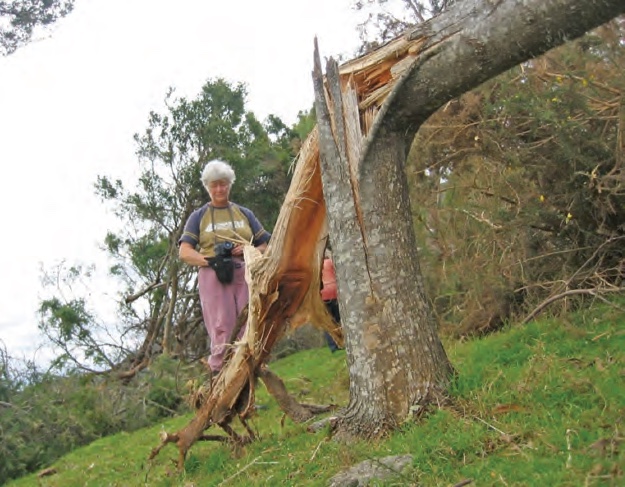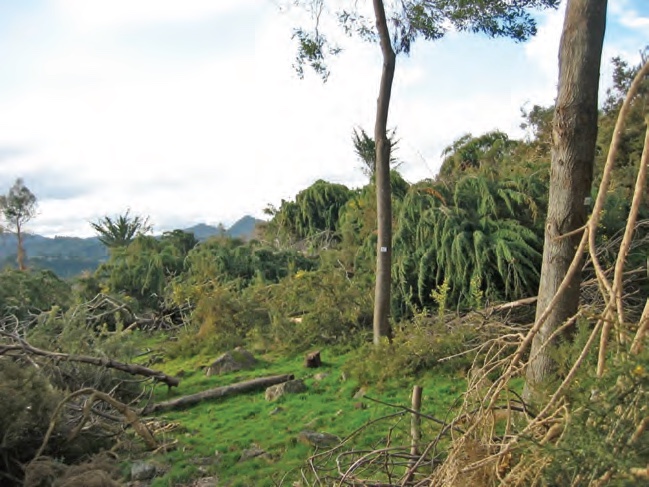Blowing in the wind – trees on the Coromandel
Jeanette Fitzsimons, New Zealand Tree Grower November 2014.
There have been a few severe storms in the past year and the aim is to get some accounts of the damage to trees and forests from these storms as future Tree Grower articles. However strong winds are a regular occurrence and this short article reminds us that we have to be prepared. Editor
Coromandel storms soon teach you which trees are most vulnerable to wind damage. In the Kauaeranga Valley near Thames the big one was July 2007, often known as the Northland storm, but it was actually worse on our peninsula. That was the year we understood why, when we built our house, the council had required 150 millimetre studs, braceline gib board and other expensive measures to withstand 200 kilometre-an-hour winds. A number of houses in the valley lost their roofs, but ours held.
The Christian Camp had a new gymnasium due to be opened the following weekend. Its steel framework was featured on the television news lying around the paddock like crumpled paper. That was just across the valley from our main plantation – a point where the valley narrows and gusts reached 200 kilometres per hour.
Once we had cleared up the damage from big kanuka branches falling on the roof and breaking the barge-board we found the olives, which were 2-year-old trees. About a quarter of them had ripped out of the ground with just a fraction of root still attached. One had been flipped over the fence into the next paddock. We replanted and staked the rest, pruning them back to about a third of their above ground bulk. They all survived, although it took a few years for them to fruit again. Most are not as vertical as they might be, but it does not seem to matter and they now crop well.

With so much damage close to the house it was two days before we found the macrocarpa. Several hundred 13 to 15-year-old trees, with diameter at breast height of around 400 millimetres and most pruned to or near six metres, were blown flat. A few snapped like match sticks about a metre above the ground, but most were uprooted, their giant root plates sticking some two to three metres vertically. Only one from that paddock, the runt of the bunch, was still standing.
The main block of these were planted in groups of three, 10 metres between groups, following Neil Barr’s early prescription allowing grazing in between. I suspect this made them more vulnerable, and I would not do it again as it made for a lot more pruning. Each group included one clone and two seedlings. The clones did so poorly they were the first we removed. Those further up the hill were planted at two by three metres – to the extent you can in steep uneven and rocky ground – and a few of them survived.

The blackwoods in the same paddock were more resistant – we had expected the opposite. We lost 20 to 30 per cent of various groups, even those down on a river terrace sheltered by a big cliff. They were mainly snapped rather than uprooted, with some of them split in the crown. They were more likely to lean on such an angle that we assume the timber will be too stressed to mill.
These were all on hill country with very broken topography. The macrocarpa lay at all angles making it dangerous to move around and difficult to clear the site. Paul Millen gave us valuable advice on using a Wood-mizer to saw the macrocarpas so we just covered the cost of clearing the site. We also got a lot of firewood, but no other return for 15 years of work. It was heartbreaking to see the slabs come off the mill, the firewood totally clean of knots but the core quite knotty. They needed a few more years.
Pecans and chestnuts
On the river flats we have pecans and chestnuts. The 2007 storm did not bother them much, possibly because they had no leaves, but also because the winds can be incredibly localised. Sometimes they corkscrew along the valley sides, at other times they only damage the flats.
Pecans are very wind sensitive and any decent blow will bring big branches down and split forks, but we were warned of that when we planted them. Sometimes it is as though a twister has been through and the long light branches are corkscrewed around each other. They have shelter, but it does not seem to help much.
The March 2014 wind
The March 2014 blow smashed three big trees to pieces, heavy with the first decent nut season we had had, but they did not blow over – the very long taproot holds what remains of them vertical. I would describe them as smashed rather than broken as the result is very messy.
The chestnuts in the same paddock are remarkably resistant and we have had little or no damage in the 20 years they have been there. So in order of wind resistance our experience is chestnuts, blackwoods, olives, macrocarpa, pecans.
Jeanette Fitzsimons and her husband Harry Parke farm chestnuts, olives, pecans and livestock organically on steep Coromandel land.

 Farm Forestry New Zealand
Farm Forestry New Zealand

